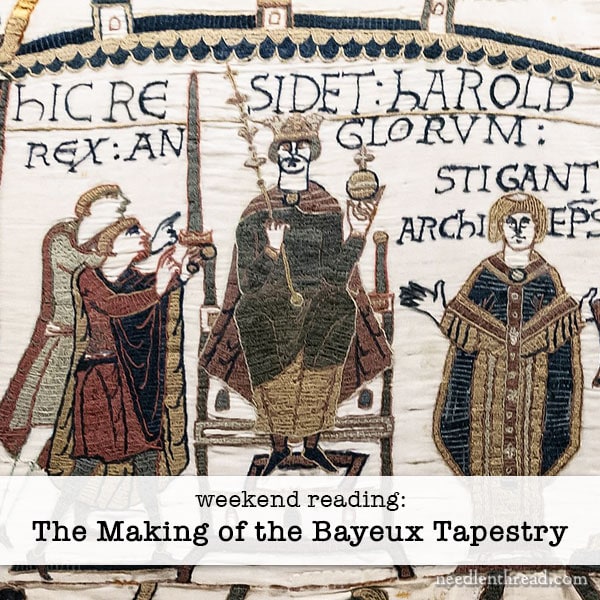When it comes to historical pieces of embroidery – large historical pieces of embroidery, especially – it would be difficult to conceive of one that is more widely known than the Bayeux Tapestry.
I like the Bayeux Tapestry. I like the history of the era. It’s a subject that always holds me fascinated.
So when this particular article popped up in the newsfeeds a week or so ago, I knew I had to share it with you – it makes good weekend reading!

“The Making of the Bayeux Tapestry” is an extensive article on History Extra, the website for BBC History Magazine and BBC World Histories Magazine.
The article, which is written in a question & answer format interviewing Alexandra Lester-Makin, PhD Medieval Embroidery and professional embroiderer, answers all kinds of questions about the tapestry, from how it was made and who made it to what the future holds for the tapestry.
It’s a thoroughly insightful article, more so than the brief glimpses that have surfaced in the news over the proposed visit of the tapestry to the UK.
One of my biggest beefs when it comes to articles written today on specific historical topics is the lack of research into primary sources, replaced instead by broad generalizations stated as accepted facts. I like the fact that Dr. Lester-Makin avoids this approach in the article. She presents various theories that could provide answers to some of the questions, but she makes it clear that they are theories open to more research, and not proven facts.
It’s a good article! If you like the history of needlework, I think you’ll enjoy reading it!
Hope you have a marvelous weekend, with a little bit of time (or a lot!) for your needle and thread!







Thanks a lot for sharing this article, Mary! It makes a good weekend lecture.
In Norfolk, UK, we are making a ‘Bayeux Tapestry’ type embroidery and a wide range of other textiles for the Norwich Castle Museum’s re-furbishment of its Keep as a 12th century royal castle keep – with hall, bedchamber and other areas! Alexandra Makin-Lester’s work has been invaluable to me (along with that of others, notably Gayle Owen Crocker) in my researching of the linen, wool and the actual stitching of the embroidery, as it has to be museum quality and I wanted to get as close as we feasibly could to the look, feel and techniques of the extant piece. We have now got started on the first 12m or so of the 18-20 m work and it’s looking good!
Re: the Bayeaux Tapestry
England has it’s own copy of the tapestry. It was the idea of Elizabeth Wardle and it was stitched by the ladies of the Leek Embroidery Society in 1885. The copy if held in the Reading Museum and for further information, here is a link to their website:
https://www.readingmuseum.org.uk/blog/five-things-you-probably-didn%E2%80%99t-know-about-reading%E2%80%99s-bayeux-tapestry
Thanks for this article, Mary. I saw the Bayeux Tapestry just about a year ago, and although I crossed it off my bucket list, I wouldn’t mind going back again. In preparation for, and as a result of, seeing it, I have been reading extensively about it (one book leads to two more!) and volunteered to put together a talk about it for my local EGA chapter, which I’ll give in about three weeks. I haven’t yet actually read the article you referred us to, but will later on today. My only problem with my talk will be trying to weed out the most interesting facts about the Tapestry to fit into one hour!! I’m also working on one of the kits with a scene from the Tapestry available from https://www.bayeux-broderie.com/gb/ It has been interesting and thought-provoking to work the actual techniques of the Tapestry while preparing to speak about it.
Hey Mary,
Thank you so much for this article on the Bayeux Tapisserie. I always wanted to learn more about this story. I have a friend in France, she made a replica of this embroidery.
I will read this a bit at a time, there is lots to discover.
Best regards,
Louise
Mary, Do you know of any classes that can be attended via Skipe? I live in Georgia, in the mountains, and there are no hand embroidery groups that I can find; machine, yes; hand, no. I am a trifle beyond beginner status, though not much. I strongly feel I would benefit by a class participation, but where? I turn to you because your tutorials have taught me what I do know, and I feel comfortable in your care. So, the question about any classes that allow participation by Skipe?
Thank you for your time.
Semi-Arthritic Dorothy Griffin
Talkin Rock, GA
Hi, Dorothy – I don’t know of any classes offered via Skype, off the top of my head, but maybe someone else out there will chime in with a recommendation! There are lots of online classes available, but via Skype is a completely different situation.
Thank you for sharing! I had heard of the Bayeoux Tapestry, but didn’t really know anything about. Now after reading the your post & the link you shared, I have a new admiration and appreciation for it. 🙂
I am curently working on a Christmas ornament project that I started years earlier. It is a Temari ball pattern. It took me a full night to remember just HOW to follow the directions! I completed 6 so far using several colors of red, maroon and green and gold for the trim. This Temari pattern weaves threads over and under each other and is quite a lot of fun to see the results.
Do you have classes on Bayeux Tapistery